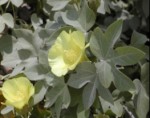Scientific Name: Gossypium tomentosum
Endemic: All HI except Hawaii Island
Description: Shrubs with pale green palmate leaves which have a light covering of silvery hairs called tomentose, which is how it gets its name. The flowers are very attractive being bright yellow, opening in the morning and closing by the next day. After the flowers are pollinated they develop into hard seed capsules about an inch in diameter. When the capsules become ripe they dry up and crack open revealing the small light brown cotton balls within. Unlike the commercial cotton we are used to seeing this type of cotton has short hairs making them not as useful as the other one. Ma’o can reach heights of three to four feet tall.
Distribution: This is an increasingly rare plant now listed as threatened but still found in limited populations on all of the main islands except Hawai’i in dry, rocky coastal sites up to about 300 ft. in elevation.
Cultural Uses: Ma’o can be strung into lei but primarily this plant was used to make a green dye, hence the name ma’o (green), but it was made from the yellow flowers.
Landscape Uses and Care: This is the perfect plant for the xeric gardener or for anybody interested in a brown-thumb friendly plant. It is basic to take care of and requires practically no water once established. It makes a nice low, dense border plant, not hedge, it looks better if left to look natural and not hedge shaped. If you do have to cut it back use a pair of clippers and remove only the areas you need to. The more sun and less water you give it the more silvery the foliage will become. Look out for aphids and white flies but both are easy to take care of with store bought pesticides. Plants that are grown slower, with less watering that build up a more silvery sheen will be a little less vulnerable to pests.
Extra Info: This plant help save the American cotton industry when it was hybridized with the commercial cotton to prevent further destruction caused from the caterpillar of a butterfly which fed on the nectar of the plant. The Hawaiian cotton lacks the flavor lactones within the nectar which would otherwise attract the butterfly to the commercial cotton, but it was the butterfly’s caterpillar that would inflict the damage on the cotton plant. Now without the good nectar the butterflies don’t show up.
Mao
